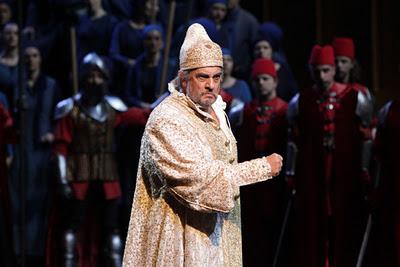Plácido Domingo's Simon Boccanegra, from La Scala.

Plácido Domingo gets elected in Simon Boccanegra from La Scala.
Photo by Marco Brescia © 2010 Archivo Fotografico del Teatro alla Scala.
This DVD, filmed at La Scala in 2010, is the third visual record of tenor Plácido Domingo's attempts to scale the summit of Verdi baritone repertory: the title role in Simon Boccanegra. For the most part, it is a success, thanks the the sensitive, intelligent conducting of Daniel Barenboim.
There is no question that Mr. Domingo commits himself wholly to acting the part of Boccanegra. But it sounds like what it is: a thickened, aged tenor voice pushed down to the bottom of its register, struggling to avoid those heights to which he can still scale. Without the low-end bloom and rich, baritonal sound that is expected from this authoritative character. He produces a noble tone in certain scenes, but lacks the dark mystery in his voice that makes this wily pirate turned politico an attractive protagonist.
Verdi's opera has struggled for decades to find its place in the repertory, and this is the 1881 revision that the composer made in collaboration with Arrigo Boito. That means the full Council Chamber scene is included. Mr. Domingo radiates power in this scene. But (and this is not the singer's fault) the next two acts are anticlimactic, culminating in death by slow poison.
There is a pretty good supporting cast. Ferruccio Furlanetto leads it as the aged, vengeance-obsessed nobleman Fiesco. His "Il lacerato spirito" is powerful and venomous, as is the confrontation with Simon in the opera's prologue. Baritone Massimo Cavaletti is adequate as the scheming Paolo, although he lacks the last bit of oily evil.
The revelation here is the pointed, sensitive portrayal of Amelia, the Doge's long-lost daughter, by Anja Harteros. She is at her best in the long duet with Mr. Domingo, although the warmth of their reunion is undercut by an ugly, jumbled set. Their recognition scene is the best moment in this performance, helped by sensitive accompaniment in the pit from Daniel Barenboim.
Visually, Federico Tiezzi delivers an acceptable production in the European mold, The spare sets (by Pier Paolo Bisleri) may have been borrowed from Robert Wilson's Orfeo. The Council Chamber scene, dominated by an immense throne, moves all of Genoa to the lip of the La Scala stage for maximum sonic clarity. However the meaning of slowly descending, rootless trees and a giant suspended mirror (in the last scene) remains murky.
Fabio Sartori does not make a huge impression as Gabriele Adorno. It is frankly a small, ungrateful tenor part. In writing this opera, Verdi poured all of his gifts into the leading role for the baritone. It's small wonder that Mr. Domingo was willing to take the risk in order to tackle the biggest part in the opera. If you're a Domingo addict, see this performance. But to hear what Verdi's great political drama is really about, get a recording (Abbado!) where a baritone sings the role.
Don't take my word for it. Here's a preview of the performance.

